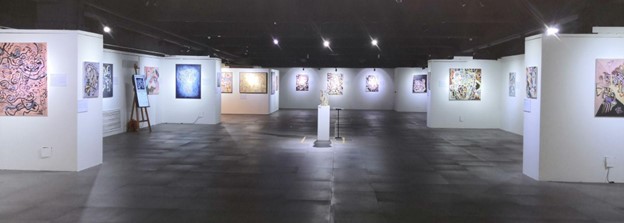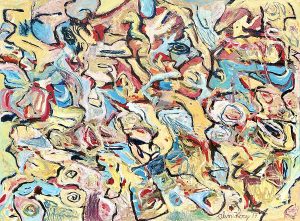Alvin Koay is a self-taught artist from Penang. Digital Osmosis is his self-curated exhibition in Penang State Art Gallery where he is exhibiting his paintings in public for the first time.
By Eeyan Chuah
Koay greets me outside the Penang State Art Gallery where his first solo exhibition, Digital Osmosis, is being held. We start chatting a bit about his background and how he, a digital entrepreneur, finds himself as an artist and how he combines his two passions in his digital and generative art. As we chat I take a peek through the glass doors and am slightly confused. Most of the artworks on display are acrylic paintings on canvases.
“Which way do I go?” I inquire.
“This way,” he points at the first partition wall to my left and gestures in a clockwise motion.
The layout is straightforward: all the works are up against the wall leaving the gallery space empty in the middle, save for a single sculpture piece on a pedestal—a painting on a piece of chopped tree trunk.
The exhibition begins with two paintings hanging side by side. The subjects are very much open to interpretation as the paintings are entirely of abstract strokes without any figurative point of reference, although the texts beside them do give some context. These paintings are from a series of works completed in 2017, the year he started painting actively after joining his children’s art lessons. They are inspired by one of his favourite artists, Willem de Kooning. The style is very much that of abstract expressionism, the movement made famous by de Kooning and Jackson Pollock, just to name a few. The entire canvas is coated in paints of bright colours, outlined with dark lines of twirls and squiggles. The effect is an all-over composition with no single point of entry. No one section stands out more important or less interesting than others. It simply draws the viewer’s eyes across the entirety of the canvas. What derives from the anti-figurative aesthetic is an emotional intensity and a sense of spontaneity and even rebelliousness.
As I turn a corner, I notice a shift in style and colour palette. The colours are earthier: rusty red, dark blues and greens, and shades of grey. From here on, the influence of Picasso and Basquiat is prominent throughout the rest of the exhibition. The drawings are less abstract and more formative, yet they are riddled with symbolism and surrealism and some are compositioned in cryptic cubism. No one except the artist could possibly unravel their origins (again, the text next to each painting is helpful), and it adds a sense of mystery to all the works.
“How would you describe your process?” I have to ask. Koay explains that every artwork really just starts with a blank canvas and with nothing in mind. Each stroke is guided by his intuition and the intention behind them would eventually reveal themselves to him, sometimes midway through the painting, other times long after the painting is completed. It is as if his subconscious is having a conversation with the canvas. Sometimes it is venting, other times it is reminiscing.
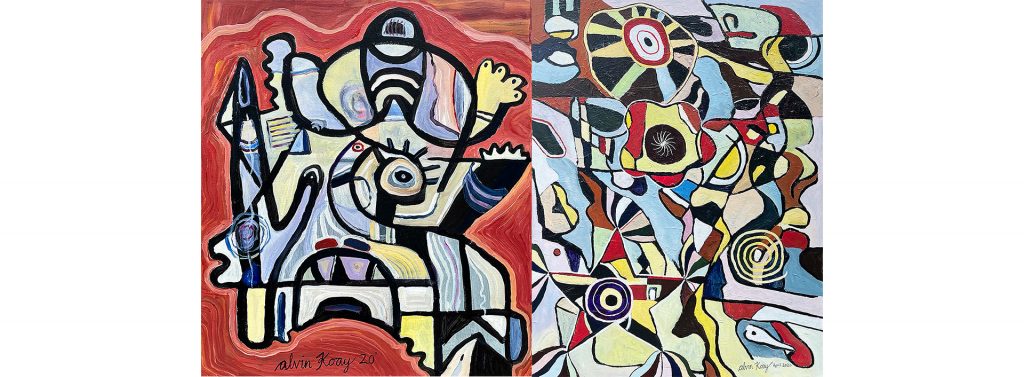
From left: Hi-Bye Friends, 2020, 20 x 24in; My Broken-down Car, 2020, 36 x 48in; both acrylic on canvas.
Most of the works exhibited were painted during the Covid lockdowns and each of them represents the artist’s reflection on what was going on in his life and in the world. There is a piece on the Black Lives Matter movement. There is one of the artist’s own rendition of Edvard Munch’s Scream, depicting his own frustration during the pandemic. There are tributes to family members and pets, as well as artworks lamenting family squabbles and political fiascoes. A clockwise stroll along the gallery’s walls turns out to be a journey through an artist’s visual diaries, each artwork a fresh entry. The experience is personal and intriguing, just like reading the diary of a stranger.
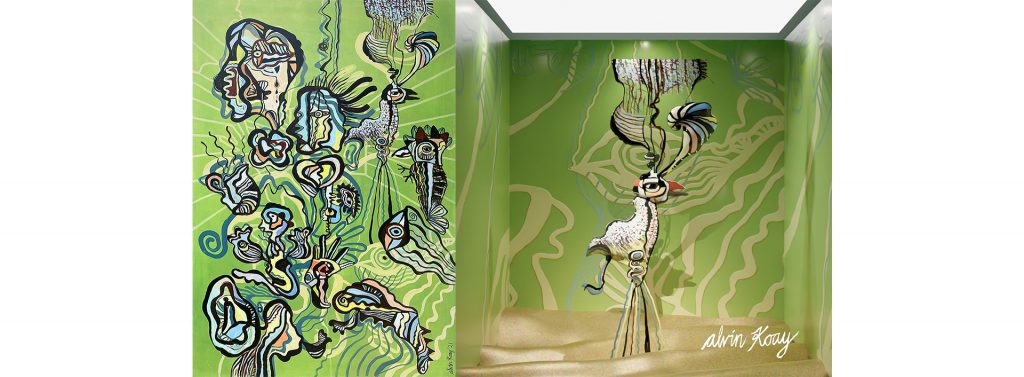
From left: The Hypocrites, 2021, acrylic on canvas, 48 x 72in; The Religious Bigot, a frame from a 3D digital animation of one of the characters in the painting.
Dotted among the canvases hanging on the walls are screens propped up on easels, screening animated digital versions of the paintings, thus, Digital Osmosis. Most impressive and memorable to me are the animations of The Hypocrites, where each character from the painting has been brought to (digital) life as a dancing animation, revealing a 360° view rotating each character.
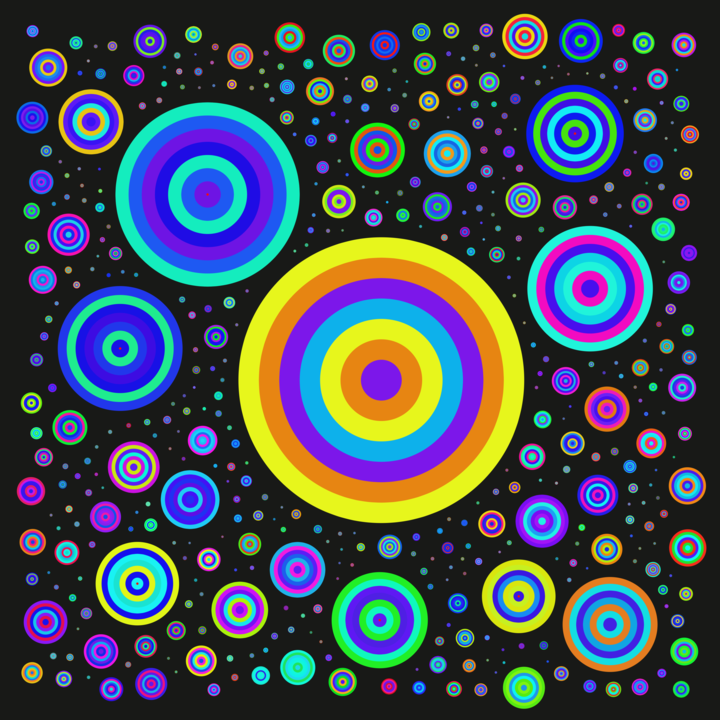
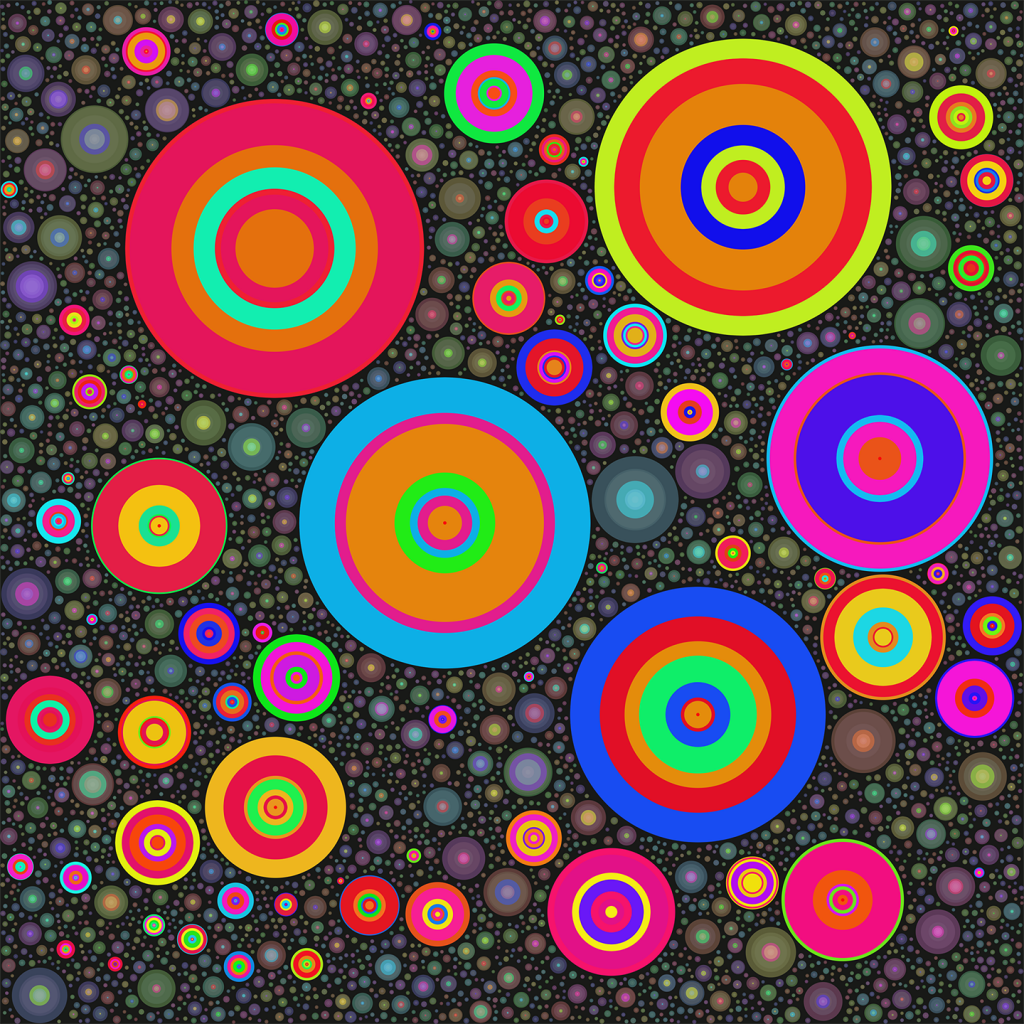
From Left: Blue Yonder; Seven Awakenings. Two of the Bulat-bulat generative art series.
To the far right wall of the gallery is a door entering a darkroom showcasing some video projections on loop. There is one showing a time-lapse video of his painting process, and another showcasing all 1,100 editions of generative art from his Bulat-Bulat series which are all generated by a unique algorithm coded by his son.
After I finish a whole loop around the gallery, I find myself back at the entrance, this time facing the wall at the right side where a single painting hangs, another abstract piece from his 2017 series titled A Million Things in My Mind, which looks like it was painted in a million strokes. After having been taken down a trip of his personal artistic journey, it is befitting, to come back to where he began.
What can you take away from Alvin Koay’s art? Abstract art and surrealism more often than not can be intimidating rather than inspiring. Even the generative digital art is a bit of the puzzle for most, what with the algorithms and coding involved. For me, I think we love artists like Basquiat, Picasso, and De Kooning simply because there is a sense of rebelliousness that comes from animating the harsh in life into an almost cartoon-ish, nonsensical form. It is that sense of taking control of your own narrative and telling your story in your own form.
When we encounter art forms like that, it is almost like experimental theatre. We might not know what we are getting ourselves into but we tend to leave the theatre with a sense of envy for the people on stage who are brave enough to throw caution in the wind and express themselves freely.
Eeyan Chuah is a writer based in Penang.
All images courtesy of Alvin Koay, unless otherwise stated.

